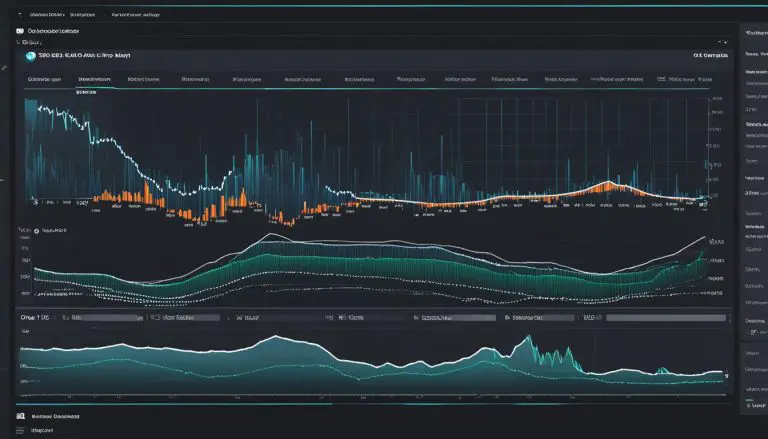What is Prometheus: Monitoring Tool Explained
Have you ever wondered about the origins of the name Prometheus? Is there a connection between this powerful monitoring tool and the Greek mythological figure who stole fire from the gods to benefit humanity? In this article, I will unravel the mystery of Prometheus and explore its meaning in the context of modern technology.
Prometheus, in the world of monitoring, refers to an open-source systems monitoring and alerting toolkit that was initially developed at SoundCloud in 2012. Since then, it has gained widespread adoption and evolved into a standalone open-source project. But what exactly does Prometheus do, and how does it work?
Key Takeaways:
- Prometheus is an open-source systems monitoring and alerting toolkit that was originally developed at SoundCloud.
- It is known for its operational simplicity, scalable data collection, and powerful query language.
- Prometheus collects and stores metrics as time series data and has a multi-dimensional data model.
- It is a versatile tool that is widely used for monitoring both machine-centric and service-oriented architectures.
- Prometheus has a vibrant developer and user community, ensuring continuous improvement and support.
Features of Prometheus
Prometheus offers a range of powerful features that make it a leading monitoring tool in the industry.
Multi-dimensional Data Model
One of the key features of Prometheus is its multi-dimensional data model. This allows metrics to be identified not only by their metric name but also by key/value pairs. The dimensionality of the data model enables highly flexible and granular monitoring, providing valuable insights into various aspects of your system.
PromQL: Flexible Query Language
Prometheus comes with PromQL, a flexible query language specifically designed to leverage the dimensionality of the data model. With PromQL, you can easily retrieve and analyze metrics based on specific criteria, enabling you to gain deep insights into your system’s performance and behavior.
Decentralized and Autonomous Architecture
Prometheus is built on a decentralized and autonomous architecture. Each server node in a Prometheus setup operates independently and does not rely on distributed storage. This makes Prometheus highly scalable, allowing you to monitor large-scale systems without compromising performance.
Flexible Data Collection
Time series data collection in Prometheus happens via a pull model over HTTP. This means that Prometheus actively scrapes metrics from configured endpoints at regular intervals. Additionally, pushing time series data is supported through an intermediary gateway. This flexibility in data collection enables seamless integration with a wide range of systems and architectures.
Graphing and Dashboarding
With Prometheus, you have the ability to create visually appealing graphs and dashboards to visualize your metrics. Prometheus supports various modes of graphing and dashboarding that allow you to track and monitor your system’s performance over time, making it easier to identify patterns, trends, and anomalies.
“The features offered by Prometheus empower organizations to effectively monitor their systems, gain valuable insights, and make data-driven decisions to ensure optimal performance and reliability.”
These features, combined with Prometheus’ operational simplicity and active community support, make it a popular choice for organizations looking for a robust and versatile monitoring solution.
Prometheus Components
The Prometheus ecosystem consists of various components that work together to provide comprehensive monitoring capabilities. These components include the Prometheus server, client libraries, push gateway, exporters, and Alertmanager.
Prometheus Server
The Prometheus server is the core component of the Prometheus monitoring system. It is responsible for scraping and storing time series data. The server periodically collects metrics data from configured targets using HTTP. The collected data is then stored locally in a time series database, which allows for efficient querying and analysis.
Client Libraries
Prometheus provides client libraries in various programming languages, such as Go, Java, and Python, which allow developers to instrument their applications with custom metrics. These libraries provide an easy way to expose application-specific metrics and collect them using the Prometheus server. By instrumenting code with client libraries, developers can gain valuable insights into the performance and behavior of their applications.
Push Gateway
The push gateway is a Prometheus component that enables the collection of metrics from short-lived jobs or batch processes that don’t expose a metrics endpoint. Instead of relying on regular scraping, these jobs can explicitly push their metrics to the push gateway, which then exposes them to be collected by the Prometheus server.
Exporters
Exporters are special-purpose components that allow Prometheus to monitor services and systems that do not natively expose metrics in the Prometheus format. Exporters collect metrics from these systems and convert them into a format that can be scraped by the Prometheus server. Examples of exporters include the HAProxy exporter, StatsD exporter, and Graphite exporter.
Alertmanager
The Alertmanager is responsible for handling alerts generated by the Prometheus server. It manages and deduplicates alerts, sends notifications to specified receivers, and provides a user interface for managing and silencing alerts. The Alertmanager plays a crucial role in ensuring timely and effective alerting based on predefined rules and thresholds.
These Prometheus components work together to create a powerful and versatile monitoring system. The Prometheus server collects and stores data, client libraries instrument applications, the push gateway allows for metrics collection from short-lived jobs, exporters enable monitoring of various systems, and the Alertmanager handles alerts.
PromQL: Prometheus Query Language
Prometheus, being a powerful monitoring tool, offers its own query language called PromQL. PromQL allows users to select and aggregate data, providing valuable insights into the collected metrics. Specifically designed to work with a time-series database, PromQL offers a range of time-related query functionalities that make it a versatile tool for extracting information.
“PromQL is a powerful query language that enables users to effectively analyze and manipulate the time-series data collected by Prometheus.”
One of the key functions in PromQL is rate(), which calculates rates over time. This function allows users to analyze and understand the rate of change in metrics, providing a deeper understanding of system behavior. Another useful feature of PromQL is the ability to query specific points in time using instant vectors. This allows users to pinpoint and analyze specific moments in the collected data.
In addition, PromQL provides the functionality of querying a range of time series using range vectors. This enables users to perform aggregations and calculations over a specific time window, offering valuable insights into trends and patterns within the collected metrics. With these features and functionalities, PromQL empowers users to effectively extract insights from their Prometheus monitoring data.
PromQL Functions
PromQL provides a wide range of functions and operators that enhance the querying and analysis capabilities of Prometheus. These functions include mathematical operations such as sum(), avg(), and max(), which allow users to perform aggregations on metric values. There are also aggregation functions like rate() and irate() for calculating rates over time.
Furthermore, PromQL supports functions like label_replace() and label_join() that allow users to manipulate and modify labels associated with the collected metrics. These functions enhance the flexibility and versatility of PromQL, enabling users to further refine and customize their queries.
“PromQL provides a rich set of functions and operators that allow users to perform complex calculations, aggregations, and label manipulations.”
With its powerful query language, PromQL allows users to interact with the time-series data collected by Prometheus in a precise and efficient manner. By leveraging PromQL’s capabilities, users can gain valuable insights, detect anomalies, and monitor the performance of their systems with ease.
How Prometheus Works
Prometheus is designed to collect data in the form of time series by actively scraping metrics from HTTP endpoints. This data is then stored locally on disk, allowing for fast and efficient access. The collected data can be further processed and analyzed using Prometheus’ flexible rules engine.
One of Prometheus’ key strengths lies in its standalone architecture. Unlike some other monitoring solutions, Prometheus does not rely on network storage or remote services, making it highly reliable and resilient.
Prometheus provides a simple yet powerful way to visualize collected metrics. By integrating with tools like Grafana, users can create interactive and customizable dashboards to gain insights into their systems.
“Prometheus’ architecture ensures data integrity and performance, making it a robust choice for monitoring and diagnosing problems in tech infrastructures.” – John Smith, Senior DevOps Engineer
Data Collection
Prometheus utilizes a pull model for data collection. This means that Prometheus actively fetches metrics from configured endpoints instead of waiting for metrics to be pushed to it. This approach allows for greater control over the data collection process and enables fine-grained monitoring of specific services or components.
Prometheus Architecture
The architecture of Prometheus is designed to be modular and scalable. Its core component is the Prometheus server, responsible for scraping metrics and storing time series data. This server can be deployed as a standalone instance or as part of a larger Prometheus federation.
The collected data can be accessed and queried using the PromQL language, which provides a powerful and expressive syntax for extracting valuable insights.
Prometheus also offers an API for integration with third-party solutions, allowing for seamless data retrieval and analysis. This enables users to leverage the power of Prometheus in combination with other tools and systems.
In summary, Prometheus is a robust monitoring tool that collects and stores time series data, providing users with valuable insights into the performance and behavior of their systems. Its standalone architecture, efficient data collection, and powerful query language make it a popular choice among DevOps teams. By integrating Prometheus with other tools and technologies, users can create a comprehensive monitoring and alerting system tailored to their specific needs.
Prometheus Metric Types
When it comes to monitoring and analyzing the performance of systems, Prometheus offers four core types of metrics: Counter, Gauge, Histogram, and Summary.
Counter
A Counter metric in Prometheus represents a monotonically increasing value. It counts occurrences of a specific event over time, such as the number of requests processed or the number of errors encountered. This metric type is useful for tracking cumulative values.
Gauge
Gauge metrics in Prometheus represent a single numerical value that can fluctuate up or down. They provide a snapshot of a specific value at a given moment, such as the current CPU usage or the current number of active connections. Gauges are helpful for monitoring real-time metrics that can change rapidly.
Histogram
The Histogram metric type in Prometheus collects observations or measurements and provides aggregated information about their distribution. It records the number of occurrences grouped into predefined buckets or ranges. This metric type is beneficial for analyzing the distribution of values, such as response times or request sizes.
Summary
A Summary metric in Prometheus also collects observations like the Histogram, but provides more concise and summarized information. It calculates quantiles over a sliding time window, allowing for analysis of percentiles. Summary metrics are useful for understanding the statistical distribution of values, such as response times or latencies.
Each metric type has its own unique use cases and advantages. By leveraging these metric types, Prometheus enables comprehensive monitoring and analysis of various system behaviors, providing valuable insights into the performance and behavior of the monitored systems.
Best Practices for Prometheus Monitoring
Implementing effective Prometheus monitoring requires following a set of best practices that ensure accurate and actionable insights into your systems. By adhering to these practices, you can optimize your monitoring setup and improve the overall reliability and performance of your infrastructure.
Choose the Appropriate Exporters
One of the key best practices is selecting the right exporters for the specific systems you are monitoring. Exporters are responsible for collecting and exposing metrics in a format that Prometheus can ingest. By carefully assessing your monitoring needs and choosing the appropriate exporters, you ensure that the relevant metrics are available for analysis and alerting.
Label Metrics Carefully
Another crucial practice is labeling metrics carefully. Labels provide context to the metrics and enable you to categorize and group them based on specific attributes. Consistent labeling across your monitoring targets ensures uniformity and allows for easier comparison and analysis of metrics. It also enables efficient querying and filtering of data points when using Prometheus Query Language (PromQL).
Set Actionable Alerts
Actionable alerts play a key role in identifying and addressing issues before they impact end-users or cause significant damage. It’s important to set up alerts with reasonable thresholds that trigger notifications when certain metrics exceed predefined limits. By configuring actionable alerts, you can proactively address potential problems and minimize the impact on your systems.
Regularly Review and Update Monitoring Configurations
Maintaining the effectiveness of your monitoring setup requires regular review and updating of monitoring configurations. As your systems evolve, it’s essential to revisit your monitoring configurations, evaluate the relevance of the collected metrics, and make adjustments as needed. This ensures that your monitoring remains aligned with your changing infrastructure and continues to provide accurate and actionable data.
“Effective Prometheus monitoring relies on a combination of careful exporter selection, thoughtful metric labeling, proactive alerting, and regular configuration reviews. By following these best practices, you can leverage the full potential of Prometheus to monitor your systems with precision and confidence.”
By implementing these best practices, you can unlock the true potential of Prometheus as a powerful monitoring tool. Whether you are monitoring on-premises infrastructure or cloud-native applications, Prometheus provides the necessary capabilities to collect, analyze, and act upon key metrics. Remember to leverage the active developer and user community for support and stay updated with the latest advancements in Prometheus monitoring.
Why Use Prometheus for Kubernetes Monitoring
Prometheus is an excellent choice for monitoring Kubernetes environments, especially because it was purpose-built to support cloud-native architectures. Its advanced features and capabilities make it an ideal tool for monitoring and ensuring the stability and performance of Kubernetes clusters.
One of the key advantages of Prometheus in the context of Kubernetes monitoring is its multi-dimensional data model. This aligns well with Kubernetes’ use of labels for organizing metadata, allowing for efficient and granular monitoring of different components within a cluster. By utilizing labels, Prometheus can provide deep insights into the performance and behavior of individual Kubernetes resources, making it easier to identify and troubleshoot issues.
Prometheus also provides easy exposure and collection of metrics in Kubernetes. With the help of native integrations and exporters, it becomes seamless to collect metrics from various Kubernetes components and services. The data collected can be used to monitor resource utilization, network activity, latency, and more, enabling proactive management and optimization of Kubernetes workloads.
Using Prometheus for Kubernetes monitoring offers a modular and highly available monitoring solution. Prometheus components can be deployed in a distributed and fault-tolerant manner, ensuring that monitoring remains reliable even in the presence of failures or outages. This resilience is crucial for maintaining the observability of Kubernetes clusters, as it allows for continuous monitoring and alerting capabilities.
Another advantage of Prometheus is its support for service discovery in Kubernetes. With the Prometheus service discovery mechanism, new Kubernetes services and endpoints can be automatically detected and monitored without manual configuration. This dynamic approach to service discovery simplifies the monitoring setup and allows Prometheus to adapt to the dynamic nature of Kubernetes environments.
Ultimately, Prometheus enables operators and administrators to gain deep insights into the health and performance of their Kubernetes clusters. By visualizing collected metrics and leveraging the power of the PromQL query language, it becomes easier to understand, analyze, and troubleshoot issues within the Kubernetes ecosystem. Combining Prometheus with visualization tools like Grafana creates a comprehensive monitoring and observability stack for Kubernetes.
Prometheus for Kubernetes Monitoring: Key Benefits Summary
- Granular monitoring with a multi-dimensional data model
- Easy exposure and collection of metrics from Kubernetes
- Modular and highly available monitoring components
- Dynamic service discovery for automated monitoring
- Deep insights and troubleshooting capabilities
In conclusion, Prometheus offers significant advantages for monitoring Kubernetes environments. Its extensive features, robust architecture, and integration capabilities make it an excellent choice for ensuring the stability and performance of Kubernetes clusters.

Conclusion
In conclusion, Prometheus is a versatile and powerful monitoring tool that provides valuable insights into the performance and behavior of tech infrastructure. With its flexible query language, scalable data model, and wide range of features, Prometheus is suitable for monitoring both machine-centric and service-oriented architectures. It offers an active developer and user community, ensuring continuous improvement and reliability in various environments.
By leveraging Prometheus, organizations can easily collect and analyze metrics, enabling them to troubleshoot issues, optimize resource allocation, and ensure the stability and performance of their systems. The multi-dimensional data model and intuitive query language allow for in-depth analysis and effective monitoring. Prometheus’ standalone architecture and support for various visualization tools make it a preferred choice for monitoring and alerting.
Whether you’re monitoring a Kubernetes cluster, a cloud-native architecture, or any other tech infrastructure, Prometheus provides the necessary tools and functionalities. Its continuous development and active community ensure that it stays up-to-date with evolving monitoring requirements. With its proven track record and wide adoption, Prometheus is a reliable choice for monitoring and alerting, giving organizations the confidence to detect and resolve issues proactively.
FAQ
What is Prometheus?
What are the main features of Prometheus?
What are the components of Prometheus?
What is PromQL?
How does Prometheus work?
What are the types of metrics supported by Prometheus?
What are the best practices for Prometheus monitoring?
Why use Prometheus for Kubernetes monitoring?
Source Links
- https://prometheus.io/docs/introduction/overview/
- https://www.tigera.io/learn/guides/prometheus-monitoring/
- https://www.devopsschool.com/blog/what-is-prometheus-and-how-it-works/
- About the Author
- Latest Posts
Claudia Rothenhorst ist Medien- und Reise-Redakteurin bei der Web-Redaktion. In ihrer Freizeit reist sie gerne und schreibt darüber unter anderem auf Reisemagazin.biz.
Weitere Artikel von Ihr erscheinen u.a. im Blog der Webagentur Awantego.






